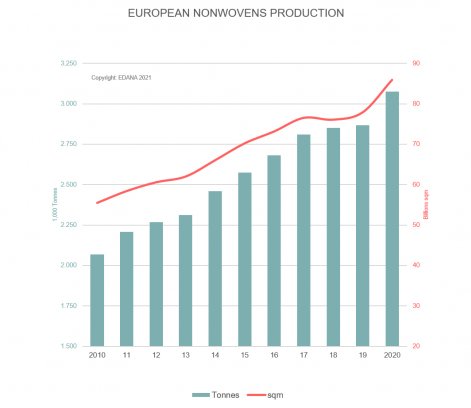
Owens Corning reports record sales
Spunmelt and drylaid-hydroentangled nonwovens witnessed double-digit growth rates.

30th March 2021
Innovation in Textiles
|
Brussels
The production of nonwovens in Greater Europe grew by 7.2% in 2020 to reach 3,075,615 tonnes (and 85.9 billion square metres) with a total estimated turnover of €9,555 million, according to industry association EDANA.
The total output of the 27 European Union countries is now over 2.15 million tonnes.
Providing a comprehensive overview of the sector, EDANA’s latest statistics demonstrate the industry’s drive and durability during a period of unprecedented change to demand drivers and supply chains.
Jacques Prigneaux, EDANA’s market analysis and economic affairs director elaborated on the main drivers for the impressive growth rate, which well outpaced the annual average growth rate over the last decade of 4%.
“The highest demand was for materials intensively used to fight the pandemic impacted the production,” he said. “Spunmelt and drylaid-hydroentangled nonwovens witnessed double-digit growth rates in both weight and surface area. Thanks to developments in similar applications, the growth in the wtlaid nonwovens was also substantial last year, but airlaid production, with opposing trends in different applications, recorded a flat situation compared to 2019.”
The main end-use for European nonwovens remains the hygiene market with a 28% share of deliveries, amounting to 857,940 tonnes, a 9.6% growth in 2020. For obvious reasons, the most significant growth areas for nonwovens in 2020 were observed in medical (+118.0%) and wipes/personal wipes (+22.0%) followed by garments (+32.6 %).
In contrast, major declines were noticed in automotive interiors (down 23%), floor coverings, table linen and interlinings. Additionally, several important durable sectors in terms of volumes sold, such as in construction markets and liquid filtration, showed limited growth and, in the case of agricultural applications, negative growth.
“Thanks to a convergence of efforts of the participating companies and of the EDANA staff in the last few years, these results are based on the collection of actual data from an increasing number of companies and not less than 118 companies/plants directly reported their 2020 returns this year,” Prigneaux said. “Increasingly accurate figures will certainly make these statistics ever more relevant for planning and benchmarking purposes within member companies,”
“Behind those figures we see first and foremost the efforts and labour of thousands of women and men who can be proud of working for companies whose purpose has always been, but is perhaps now recognised better than ever, to contribute to deliver excellence for the well-being and health of fellow citizens,” added EDANA general manager Pierre Wiertz. “The modest and yet essential role of these annual EDANA statistics – the most comprehensive available in the world – has been now for 50 years, to document this performance and provide this unique source of business intelligence to our member companies, thanks to direct input from producers and exhaustive market insight.”
Further statistical detail and analysis is available in the report, 2020 European Nonwovens Market Insights, shared with all EDANA members. Members who are nonwoven producers will receive more detailed data, in recognition of their survey participation. Members can also access comprehensive figures across a full range of applications and production processes via the EDANA Statistics App.

Business intelligence for the fibre, textiles and apparel industries: technologies, innovations, markets, investments, trade policy, sourcing, strategy...
Find out more